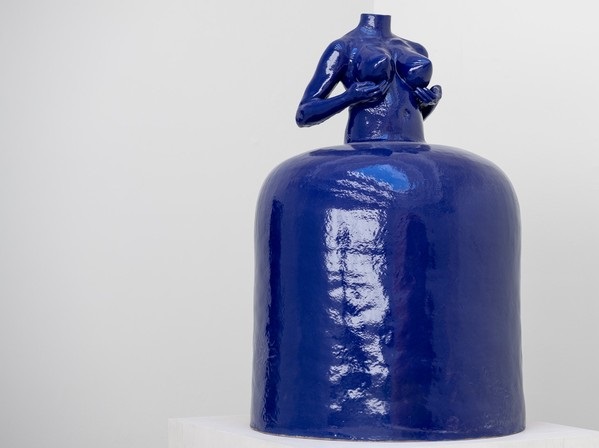
Here is a touching article (that we missed in 2022) by Nailah Reine Barnes, 2022 Reporting Fellow for the Pulitzer Center. She writes, “Simone Leigh’s layering of Black women’s experiences across generations and cultures shows me the beauty in existing in the ‘in-betweens.’” I particularly enjoyed Barnes’ account of her relationship with and deep appreciation for Leigh’s evocative piece, “Martinique” (shown above).
I am a cultural transplant. I was born in Atlanta, Georgia, surrounded by family and friends with similar culinary palates and musical tastes as mine but I was raised in rural Deerfield, Massachusetts, where miles of cow fields separated me from the next closest Black family. Growing up, this dichotomy, coupled with a year living in France, often made me feel like an outsider; I did not fit comfortably within one or even two borders, whether geographic or identity-based.
Multidisciplinary artist Simone Leigh is chief among the myriad Black American artists and intellectuals whose work and lived experiences help my loneliness subside.
Before becoming acquainted with Simone Leigh’s work for the first time the summer before my senior year at Spelman College, my construction of a genealogy chart including the scholars and artists who guide my voice and understanding of place was well underway. As an International Studies and French double major at Spelman, I took classes centered around global Black experiences, including African Diaspora and the World, Black Women in Latin America, and Survey of Francophone Literature. [. . .] My introduction to these other scholars and artists was the operative component in making my experience of Simone Leigh’s oeuvre in Venice, Italy, so astounding. The diasporic connections in her works set my mind ablaze as I saw the teachings throughout my life illuminated in harmony in Leigh’s works like Martinique (2022).
When I encountered Martinique in the U.S. Pavilion of the 59th Venice Biennale, her color and stance enraptured me instantly. She stood saliently in a shimmering blue glaze beside the deep grays, milky whites, and rich obsidian blacks of most of Leigh’s works that I had seen and studied up to that point. Her “power-pose”—hands supporting bosom, straight back, and even shoulders—radiated authoritative energy around the gallery. [. . .]
The sculpture’s namesake is an island in the Caribbean that the French colonized in 1635. Colonial settlers forced the Indigenous Carib peoples out, and for over two centuries, the French enslaved Africans to convert sugarcane into sugar and rum. Martinique remains a French territory to this day.
I interpreted Simone Leigh’s Martinique as a counter-narrative to the romanticized and saccharine stereotypes of Martinican women that the French established to help justify slavery and exploitation of Martinican people and land. The sculpture’s glaze reminded me of caramelized sugar and thus speaks to the horrors of enslavement on the island. Her headlessness is a critique of ongoing colonialism in the region; it’s as if she refuses to continue being controlled by its imperial forces acting under the guise of benevolence. Overall, Martinique echoes 20th-century Martinican author Suzanne Césaire’s text: “Too bad for those who consider us mere dreamers. The most unsettling reality is our own. We shall act.”*[. . .]
Leigh’s artistry and intellect elucidate how the creation of the diaspora is ongoing and how critical fabulation*—the practice of making productive sense of the gaps and silences in the archive of transatlantic slavery—is radical and essential. [. . .]
Author’s Notes:
*Susanne Césaire, Tropiques, no. 5, April 1942.
*Saidiya Hartman, Ph.D., a professor of English and comparative literature at Columbia University, coined the term critical fabulation in her essay “Venus in Two Acts.”
For full story and notes, see https://pulitzercenter.org/stories/how-artist-simone-leigh-helps-me-embrace-my-hyphenated-identities
[Martinique (2022) by Simone Leigh in her exhibition Sovereignty (2022) in the U.S. Pavilion of the 59th Venice Biennale; accessed via Floornature.com.]
Also see more on S. Leigh at the Venice Biennale at https://www.floornature.com/design-trends/handmade-art-simone-leigh-17029/
Here is a touching article (that we missed in 2022) by Nailah Reine Barnes, 2022 Reporting Fellow for the Pulitzer Center. She writes, “Simone Leigh’s layering of Black women’s experiences across generations and cultures shows me the beauty in existing in the ‘in-betweens.’” I particularly enjoyed Barnes’ account of her relationship with and deep appreciation







